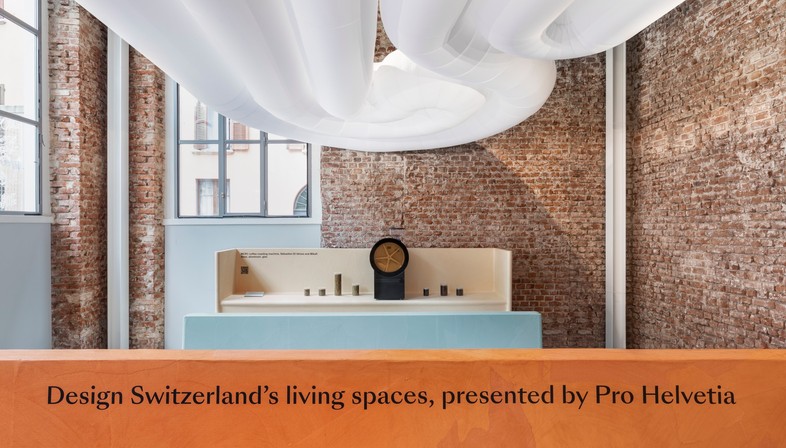
The stunning exhibition ‘Design Switzerland’s Living Spaces’ that the Swiss Arts Council Pro Helvetia organised for Milan Design Week encapsulates all the themes currently dominating today’s research scene: inclusivity, caring for the planet and our local communities, sustainability, equality, and reviving age-old traditions. The exhibition cast a spotlight on a total of nine young designers and firms based in Switzerland, along with their thoroughly-tested prototypes in the field of interior design, carefully handpicked by a jury consisting of designer Laetitia De Allegri paired with entrepreneur and expert in the creative sector, Damon Bonser. A certain consistency with the principles guiding the selection was also reflected in the staging of the exhibition itself, located on the ground floor of the Casa degli Artisti in Brera and designed by Studio iiode, deliberately crafted out of lightweight materials: modules made of structural cardboard for the sectors dedicated to each project and a white inflatable tubular coil attached to the ceiling, effectively tying together and characterising the long exhibition hall.
Studio Eidola, for example, engaged with the theme of materials with a piece of research entitled ‘Ocean Articulated’, in which salt and sand taken from the Swiss Upper Rhine area - a region that is home to deposits of a prehistoric ocean and glacial erosion - are transformed into a temporary yet durable furnishing material. The two raw materials are combined into a recyclable structural mixture which, worked by means of a simple technique and with only minimal equipment, can be moulded into objects such as tables and stools, but also tiles, all characterised by a rough, unrefined surface with an incredibly natural effect.
Noemi Niederhauser - also inspired by nature, but this time through the lens of food waste - displayed her research project ‘Waste Matter’: the malt residue from breweries in Lausanne was combined with an organic protein in order to produce a plywood-like material that can be used for furnishings or panels. In doing so, she has shown how this humble by-product of the food industry can offer an alternative to the use of wood.
在瑞士设计的设计中看到的其他原型旨在使家具的多功能性与当今年轻一代偏爱的游牧生活方式相吻合。例如,与Tricentro:由Salienti设计的桌子基础是这种情况。这个想法很简单,既聪明,也是一个有趣的想法:桌子是任何生活空间中真正重要的元素,但它通常很麻烦且不灵活。那么,为什么不创建一个易于存储的轻巧,折叠式底座,同时又强大且可重新配置呢?Tricentro为所有这些燃烧问题提供了答案:三个管状钢元素 - 由关节连接但完全可调 - 用作一侧的脚,另一侧支撑,可容纳任何类型的桌面(尽管最好是重型)。由于表达,这三个元素可以采用不同的配置,同时保持整体平衡或折叠平坦,以最大程度地减少其足迹。关于家庭空间有限的问题以及对可变配置的需求,包括在餐厅和餐饮环境中,Tricentro具有耐用,可运输和实用性。
设计师Shizuka Saito的Mingle凳子是另一件完全符合的家具,他在日内瓦的Head-Hauteécoled'Art De Desight学习了室内建筑,她现在已经建立了自己的公司。#raybet官网Mingle包含一个可扩展的网格,该网格附着在管状脚上:最小的是单座凳子,但也可以扩展到成为用户所需尺寸的长凳。
与此同时,Vervig - 由LucaGorissé领导的一个设计工作室也是一个位于日内瓦的设计工作室 - 在展览会上忘记了一半,这是一个由手工编织的碳纤维制成的房间分隔器的原型,使用藤制编织技术之一瑞士的最后一位工匠能够将它们传给子孙后代。除了保存数百年历史的手动技术外,一半被遗忘还解决了在具有轻巧且固定的物体的家庭空间中建立临时的模块化分离的必要性,这在美学上也令人愉悦;除其他事项外,它可用于界定休闲和放松区域,将它们物理与家庭工作空间分开。
(Antonella Galli)
字幕和学分
这些图像是由瑞士艺术委员会专业人士Helvetia在Fraybet官网uorisalone 2022年米兰Brera地区的Casa Degli Artisti组织的“瑞士设计生活空间”展览中提出的九个项目。由Pro Helvetia提供。
01 Studio eidola,海洋清晰,一种由盐和沙子制成的天然材料,可用于制作家具和覆盖物,朱莉娅·伊萨克(Julia Ishac)摄
02,03,11设计瑞士的生活空间,Alessandro Saletta的照片-DSL Studio
04 Studio Eidola,海洋清晰,Alessandro Saletta -DSL Studio摄影
05 Noemi Niederhauser,Waster Matter,一个研究项目,研究了啤酒厂的废物麦芽产品的再利用。
06 Salienti,Tricentro,可折叠桌腿系统
07 Shizuka Saito,Mingle可扩展凳子,Alessandro Saletta的照片-DSL Studio
08 Vevig,一半被遗忘,手工编织的碳纤维房间的原型
09Sébastienel Idrissi,MCR1咖啡烤机的原型,与Mikafi结合开发
10 Shizuka Saito,融合式凳子
12 Renaud Defrancesco工作室,现场,地板和台灯由回收铝制成
13 Mark Gerber设计,孔戴扶手椅,持久且可维修,是由当地材料和当地工匠制成的。
14亚历山德拉·格伯(Alexandra Gerber)工作室,无题的艺术品和照片创新框架系统


































